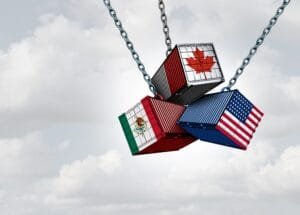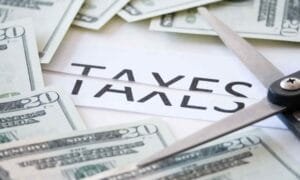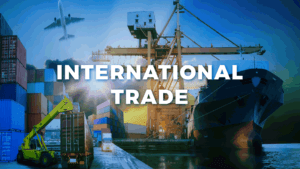The New U.S. Tariffs in 2025: What They’re Not Telling You and How It Affects You

Introduction
Do you ever wonder why your favorite imported gadgets seem to cost more this year? Or why certain industries are booming while others struggle? The answer lies in the latest wave of tariffs the U.S. government rolled out in early 2025. These new trade taxes aren’t just a footnote in trade policy—they’re reshaping supply chains, consumer prices, and even international relations.
What You’ll Learn
- Tariff Basics: Definition, purpose, and mechanics.
- 2025 Tariff Changes: Key products, rates, and effective dates.
- Economic Impacts: Effects on businesses, consumers, and global trade.
- Strategic Advice: How to navigate and even capitalize on the new landscape.
- Legal & Political Dynamics: Why the U.S. can impose first and what it means internationally.
- What a tariff is and why countries impose them.
- How the new U.S. tariffs of 2025 work in practice.
- Who benefits (and who doesn’t) from these measures.
- Hidden impacts most reports gloss over.
- Actionable strategies for businesses and consumers to adapt.
By the end, you’ll understand the full picture—beyond the headlines—and be equipped to make informed decisions as these policies take hold.
What Is a Tariff? (Tariff Meaning Explained)

A tariff is essentially a tax on imported goods. Think of it as a toll booth at the border—foreign products pay extra to enter your country. Governments use tariffs to:
- Protect domestic industries by making imported competitors more expensive.
- Generate revenue without raising domestic income taxes.
- Leverage trade negotiations by pressuring other countries to lower their own tariffs.
Simple Example
If a foreign‑made smartphone costs $500 and the U.S. imposes a 20% tariff, the importer pays an extra $100. That cost usually passes on to you, the consumer, making the phone $600 at retail.
How Do Tariffs Work in 2025?
Tariffs follow a straightforward process:
- Policy Decision: The President or Congress designates product categories and sets rates via legislation or Executive Order.
- Customs Collection: U.S. Customs & Border Protection adds the tariff at the point of entry based on the product’s declared value.
- Pass‑Through: Importers typically mark up prices to cover the added cost, so consumers—and often domestic producers—feel the impact.
Key 2025 Changes
- Section 232 Steel & Aluminum: Increased from 10% to 25% on March 12, 2025, and revoking all prior exemptions, expanding the list of covered items.
- Section 301 Digital Services: A 10% baseline tariff on imports from countries with digital‑services taxes (DSTs), effective April 10, 2025, applies to all imports except China until July 9, 2025.
- Automobiles & Parts: 25% ad valorem tariffs on non‑USMCA compliant vehicles and parts, effective April 3 and May 3, 2025, respectively.
- Venezuelan Oil: 25% tariff on any goods from countries purchasing Venezuelan oil, effective April 2, 2025.
- New Investigations: Section 232 probes into copper, timber, and semiconductors, potentially adding future tariffs.
Why the U.S. Can Impose Tariffs First—and Why It Does
— Economic Clout
As the world’s largest single market, the U.S. can wield tariffs as a powerful bargaining chip. Companies need access to American consumers, so foreign governments are often hesitant to retaliate too harshly.
— Political Motivation
The 2025 tariffs are justified as tools to:
- Protect jobs in steel, aluminum, auto, and energy sectors.
- Reduce trade deficits (the U.S. ran a $900 billion deficit in 2024).
- Counter unfair practices like DSTs and forced technology transfers.
— What People Don’t Emphasize
Many analyses miss that these tariffs are also a testing ground for more targeted measures—digital‑service taxes and “carbon border adjustments” are next on the docket.
How Tariffs Affect Businesses and Consumers

— For Businesses
- Higher Input Costs: Manufacturers pay more for raw materials (steel, aluminum) and parts, squeezing margins.
- Supply Chain Shifts: Companies relocate production or source alternative suppliers in tariff‑free countries (e.g., Mexico, Vietnam).
- Competitive Pressure: Domestic producers gain a price edge, but risk complacency and reduced innovation.
— For Consumers
- Price Increases: From electronics to home appliances, you’ll see 10–25% higher prices on many goods.
- Reduced Choice: Some brands may exit the U.S. market if margins vanish.
- Inflationary Spillover: Higher import costs can ripple through the economy, pushing up service and labor costs.
— Real‑World Example
A furniture retailer that imports steel frames now faces a 25% cost hike. Passing that on means a $500 sofa could cost $625—before adding shipping or retailer markup.
Benefits of Tariffs for the U.S.
Despite the pain points, tariffs can yield advantages:
1. Job Protection
U.S. steel mills and aluminum plants have ramped up hiring as imports shrink.
2. Trade Balance Improvement
Early data shows a 5% reduction in the steel trade deficit in Q1 2025.
3. Leverage in Negotiations
Tariffs pressure trading partners to cut their own barriers—China began talks to reduce its DST after U.S. action.
Future Outlook & Strategic Recommendations
— 2025 Trends to Watch
- AI‑Driven Tariff Analytics: Tools like TradeWatch 2025 and NutriCoach (for agri‑tariffs) will predict cost impacts before they hit.
- Supply Chain Resilience: Expect continued “China + 1” strategies—diversifying into Southeast Asia and Latin America.
— For Businesses
- Diversify Sourcing: Don’t rely solely on high‑tariff countries; build multi‑country supply chains.
- Lobby Smartly: Seek targeted exclusions—medical devices, semiconductors, and critical minerals often win carve‑outs.
- Price Hedging: Lock in raw‑material prices via futures contracts to mitigate volatility.
— For Consumers
- Buy Domestic: Support U.S.‑made goods where possible—look for “Made in USA” labels.
- Plan Purchases: If a big appliance or vehicle is on your list, buy before new tariff rates take effect.
Political & Legal Considerations

— Domestic Politics
Tariffs remain popular in manufacturing states (Ohio, Pennsylvania) but unpopular in high‑cost urban areas (California, New York), creating a partisan tug‑of‑war.
— Legal Risks
- WTO Complaints: The EU and Japan have filed challenges, arguing Section 232 measures violate trade agreements.
- Congressional Oversight: New legislation in Q2 2025 seeks to cap presidential tariff authority and require greater transparency.
Why the U.S. Targeted China (and Paused Tariffs on Others)
In early 2025, the U.S. sharply increased tariffs on Chinese imports—while simultaneously granting reprieves to virtually every other trading partner. There are three key reasons behind this selective approach:
1. Largest Trade Imbalance & Strategic Leverage:
China accounts for by far the biggest U.S. trade deficit. Imposing steep tariffs on Chinese goods gives the U.S. maximum negotiating power, since China relies heavily on American consumers. By contrast, tariffs on smaller deficits would yield less leverage.
2. Unfair Trade Practices & IP Concerns:
U.S. policymakers cite longstanding issues—forced technology transfers, intellectual property theft, and state subsidies—that disadvantage American firms. Targeting China directly addresses these systemic problems, whereas allied nations (e.g., Canada, Mexico, EU members) are viewed as adhering more closely to trade rules.
3. Closing the “De Minimis” Loophole:
The U.S. had allowed low‑value packages (under $800) to enter duty‑free—a benefit heavily exploited by Chinese e‑commerce platforms like Shein and AliExpress. In February 2025, the exemption was briefly restored for all three tariffed countries but then permanently rescinded for China and Hong Kong as of May 2, 2025, reinstating full duties on small shipments. This move specifically curbed China’s dominant cross‑border online retail presence without unduly burdening other partners.
International Responses & Retaliatory Measures
— China
On April 10, 2025, China slapped a 125% tariff on $125 billion of U.S. exports—including soybeans, pork, and tech equipment—as direct retaliation .
— EU
The European Union threatened 25% tariffs on U.S. digital services (e.g., streaming platforms) and luxury goods if talks stall.
— Developing Countries
Nations in Africa and Latin America warn that higher U.S. tariffs could push them into debt, as they lose export revenues and pay more for imports.
Mastering the Topic: Other Critical Factors
- Non‑Tariff Barriers: Quotas, standards, and customs delays can be as restrictive as tariffs.
- Currency Fluctuations: A weaker dollar offsets some tariff costs; keep an eye on forex markets.
- Environmental Tariffs: Carbon border adjustments are likely by 2026—tariffs on “dirty” imports could add another layer of complexity.
Conclusion
The new U.S. tariffs in 2025 are far more than a trade skirmish—they’re a strategic pivot in global economics. While they shield certain industries and give the U.S. leverage, they also raise costs, fuel inflation, and risk tit‑for‑tat retaliation. Furthermore detail Visit What are tariffs, how do they work and why is Trump using them?
— Your Next Steps:
Businesses: Audit your supply chain today. Identify high‑risk imports and explore alternative suppliers.
Consumers: Compare “Made in USA” vs. imported options. Time big purchases before new rates bite.
Was this helpful? Did you spot any products already feeling the tariff pinch? Let us know in the comments below!
FAQs: The New U.S. Tariffs in 2025
Q1: What exactly is a tariff?
A tariff is a tax imposed on imported goods—think of it as a “border toll” that raises the price of foreign‑made products to protect domestic industries and generate government revenue.
Q2: How do the new U.S. tariffs of 2025 work?
The 2025 tariffs are applied at customs based on each product’s declared value. Key measures include:
- 25% on steel & aluminum (Section 232), effective March 12, 2025.
- 10% on digital‑services imports tied to DST‑imposing countries, starting April 10, 2025.
- 25% on non‑USMCA autos & parts in April–May 2025.
Q3: Which products are most affected by these tariffs?
Major categories include:
- Steel & aluminum (all countries, no exclusions).
- Digital services from DST‑taxing nations.
- Automobiles and parts not made under USMCA rules.
- Energy imports (e.g., Venezuelan oil).
Q4: How will these tariffs impact consumer prices?
Importers pass the extra cost to retailers, who then raise shelf prices. Expect to see 10–25% price hikes on affected electronics, appliances, and steel‑based products.
Q5: Can businesses avoid paying these tariffs?
Yes—common strategies include:
- Supplier diversification to non‑tariffed countries (e.g., Mexico, Vietnam).
- Applying for exclusions or waivers (for critical goods like medical equipment).
- Vertical integration (bringing production in‑house).
Q6: How are other countries responding?
- China retaliated with 125% tariffs on $125 billion of U.S. exports, including agriculture and tech.
- EU has threatened tariffs on U.S. digital giants and luxury goods.
- Developing nations warn of debt and supply‑chain disruptions.
Q7: Are these tariffs good or bad for the U.S. economy?
It depends:
- Pros: Protects domestic jobs in steel, aluminum, and auto sectors; can improve trade balances.
- Cons: Raises consumer prices, risks inflation, and may slow growth in tariff‑dependent industries.
Q8: What should consumers do to adapt?
- Shop domestic: Look for “Made in USA” labels.
- Time big purchases: Buy before new rates kick in.
- Compare prices: Seek alternative brands or models less exposed to tariffs.
Q9: How can small businesses prepare?
- Audit supply chains for tariff exposure.
- Negotiate contracts with suppliers for price stability.
- Use trade‑compliance software to forecast cost changes.
Q10: Where can I find up‑to‑date tariff rates?
Check the U.S. Customs Tariff Database or tools like TradeWatch 2025 for live updates on product classifications and rates.
NOTE:
Have Questions?
Feel free to leave a comment on the post! Our team is here to respond to your queries as quickly as possible.
Thank You for Visiting Questinate!
We’re thrilled to have you explore our site for tips, knowledge, and insights. Stay updated with fresh, valuable blogs by visiting us daily.
Spread the Word!
If you found this helpful, share it with your friends and family: Questinate – Explore, Learn & Enjoy
Contact Us!
If you have any query, Contact Us – Questinate we are happy to assist you.
We look forward to seeing you again soon!
SUBSCRIBE TO OUR Newsletter – Questinate!


So this is how tarriffs work . But why do U.S would do such a thing that can lead to global market instability…?